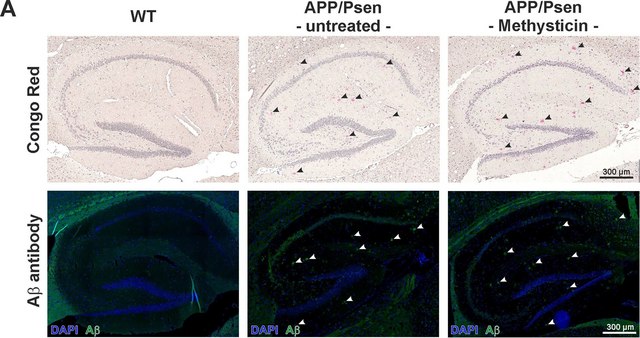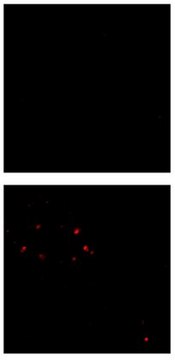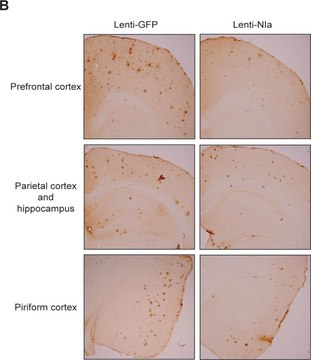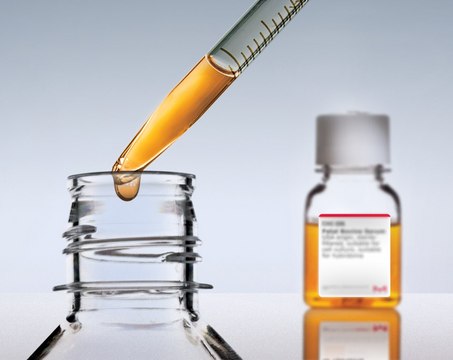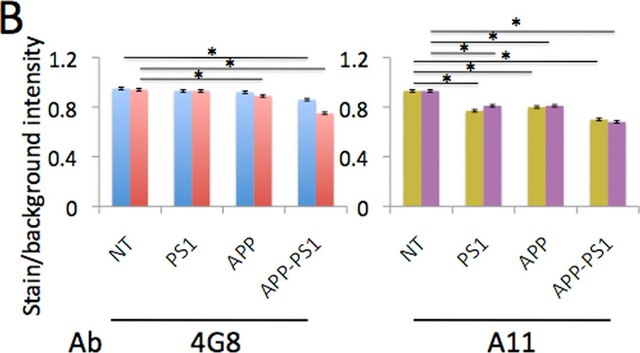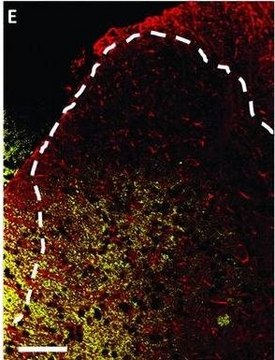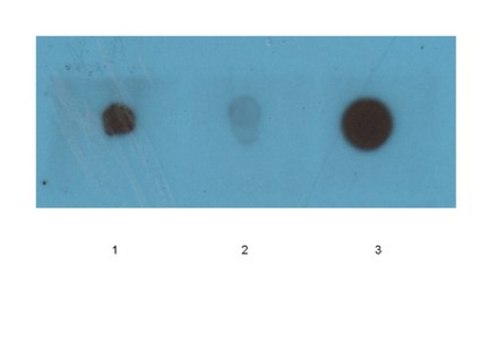ABN1650
Anti-Aβ-42 Antibody, oligomeric (VIA)
serum, from rabbit
Sign Into View Organizational & Contract Pricing
All Photos(4)
Synonym(s):
Aβ-42 oligomer, Abeta-42 oligomer, Oligomeric Aβ-42, Oligomeric Abeta-42
UNSPSC Code:
12352203
eCl@ss:
32160702
Recommended Products
biological source
rabbit
Quality Level
antibody form
serum
antibody product type
primary antibodies
clone
polyclonal
species reactivity
human
technique(s)
dot blot: suitable
immunofluorescence: suitable
immunohistochemistry: suitable
western blot: suitable
UniProt accession no.
shipped in
ambient
target post-translational modification
unmodified
Gene Information
human ... APP(351)
General description
Amyloid beta A4 protein (UniProt P05067; also known as ABPP, Alzheimer disease amyloid protein, Amyloid precursor protein, APP, APPI, Cerebral vascular amyloid peptide, CVAP, PN-II, PreA4, Protease nexin-II) is encoded by the APP (also known as A4, AD1) gene (Gene ID 351) in human. Amyloid precursor protein (APP) is initially produced with a signal peptide sequence (a.a. 1-17), the removal of which yields the mature protein with a large extracellular portion (a.a. 18-699), followed by a transmembrane segment (a.a. 700-723) and a cytoplasmic (a.a. 724-770) tail. APP can be further processed by the α-, β-, and γ-secretases in two alternative processing pathways. In the non-amyloidogenic pathway, APP is first cleaved by the plasma membrane-localized α-secretase to generate an N-terminal extracellular sAPPα fragment (a.a. 18-687) and a membrane-bound C-terminal fragment C83 (CTFα), which can be further cleaved by γ-secretase to produce a non-toxic small peptide p3 and a cytoplasmic APP intracellular domain (AICD). In the amyloidogenic pathway, APP undergoes β-cleavage in BACE-1 (β-site APP-cleaving enzyme)-enriched endosomes to generate an N-terminal extracellular sAPPβ fragment (a.a. 18-671) and a membrane-bound C-terminal fragment C99 (CTFβ). Subsequent cleavage of C99 by γ-secretase releases the amyloid β peptides, Aβ1-42 (672-713) & Aβ1-40 (672-711), and AICD. Aβ accumulation in the cortical and hippocampal regions of the brain is a major pathological feature of Alzheimer′s disease (AD). Growing evidences implicate soluble oligomers as the more toxic species and the extent of oligomer formation and assembly correlates better with disease progression and cognitive dysfunction. These Aβ oligomers are able to induce other aggregation-prone proteins, including α-synuclein (α-syn), prion protein (PrP), and TDP-43, to assume oligomeric conformations. These proteins can then seed tau aggregation, resulting in neurodegeneration.
Specificity
This polyclonal antiserum (VIA) recognizes a distinct epitope specific to Aβ-42 oligomers. VIA does not recognize classic amyloid plaques composed of fibrillar Aβ or Aβ-40 (Bodani, R.U., et al. (2015). ACS Chem. Neurosci. 6(12):1981-1989).
Immunogen
Aggregated synthetic hexapeptide VIAVIA composed of two copies of Aβ-42 C-terminal end 3-amino acid sequence (Bodani, R.U., et al. (2015). ACS Chem. Neurosci. 6(12):1981-1989).
Application
Anti-Aβ-42, oligomeric (VIA), Cat. No. ABN1650, is a highly specific rabbit polyclonal antibody that targets oligomeric amyloid beta 42 and has been tested in Dot Blot, Immunofluorescence, Immunohistochemistry, and Western Blotting.
Immunofluorescence Analysis: A 1:150 dilution from a representative lot detected oligomeric Aβ-42, but not oligomeric Tau or large amyloid plaques in Alzheimer′s diseased (AD) human brain cryosections (Courtesy of Riddhi U Bodani, Kayed lab, Univ of Texas Medical Branch, Galveston, U.S.A.).
Immunohistochemistry Analysis: A 1:150 dilution from a representative lot detected oligomeric Aβ-42 immunoreactivity in Alzheimer′s diseased (AD) human cortex cryosections (Courtesy of Riddhi U Bodani, Kayed lab, Univ of Texas Medical Branch, Galveston, U.S.A.).
Dot Blot Analysis: A representative lot detected recombinant Aβ-42, but not Aβ-40, oligomers (Bodani, R.U., et al. (2015). ACS Chem. Neurosci. 6(12):1981-1989).
Immunofluorescence Analysis: A representative lot immunostained both prefibrillar and fibrillar Aβ-42 oligomers in Alzheimer′s diseased (AD) human brain (Bodani, R.U., et al. (2015). ACS Chem. Neurosci. 6(12):1981-1989).
Immunofluorescence Analysis: A representative lot detected oligomeric Aβ-42, but not amyloid plaques in coronal sections of Tg2576AD mice harboring human Swedish mutation APP (APPK670/671L) transgene (Bodani, R.U., et al. (2015). ACS Chem. Neurosci. 6(12):1981-1989).
Immunohistochemistry Analysis: A representative lot immunostained intracellular perinuclear Aβ-42 aggregates, but not amyloid plaques in Alzheimer′s diseased (AD) human brain (Bodani, R.U., et al. (2015). ACS Chem. Neurosci. 6(12):1981-1989).
Immunohistochemistry Analysis: A representative lot detected oligomeric Aβ-42 immunoreactivity in the hippocampus CA1 region of Tg2576AD mice harboring human Swedish mutation APP (APPK670/671L) transgene (Bodani, R.U., et al. (2015). ACS Chem. Neurosci. 6(12):1981-1989).
Western Blotting Analysis: A representative lot detected oligomeric A -42, but not monomeric Aβ-42, monomeric or oligomeric Aβ-40 (Bodani, R.U., et al. (2015). ACS Chem. Neurosci. 6(12):1981-1989).
Note: Both purified antibody (Cat. No. ABN1665) and unpurified antiserum (Cat. No. ABN1650) are suitable for Dot blot, immunofluorescence, immunohistochemistry, and Western blotting applications. However, we recommend using only the purified antibody for neutralization studies.
Immunohistochemistry Analysis: A 1:150 dilution from a representative lot detected oligomeric Aβ-42 immunoreactivity in Alzheimer′s diseased (AD) human cortex cryosections (Courtesy of Riddhi U Bodani, Kayed lab, Univ of Texas Medical Branch, Galveston, U.S.A.).
Dot Blot Analysis: A representative lot detected recombinant Aβ-42, but not Aβ-40, oligomers (Bodani, R.U., et al. (2015). ACS Chem. Neurosci. 6(12):1981-1989).
Immunofluorescence Analysis: A representative lot immunostained both prefibrillar and fibrillar Aβ-42 oligomers in Alzheimer′s diseased (AD) human brain (Bodani, R.U., et al. (2015). ACS Chem. Neurosci. 6(12):1981-1989).
Immunofluorescence Analysis: A representative lot detected oligomeric Aβ-42, but not amyloid plaques in coronal sections of Tg2576AD mice harboring human Swedish mutation APP (APPK670/671L) transgene (Bodani, R.U., et al. (2015). ACS Chem. Neurosci. 6(12):1981-1989).
Immunohistochemistry Analysis: A representative lot immunostained intracellular perinuclear Aβ-42 aggregates, but not amyloid plaques in Alzheimer′s diseased (AD) human brain (Bodani, R.U., et al. (2015). ACS Chem. Neurosci. 6(12):1981-1989).
Immunohistochemistry Analysis: A representative lot detected oligomeric Aβ-42 immunoreactivity in the hippocampus CA1 region of Tg2576AD mice harboring human Swedish mutation APP (APPK670/671L) transgene (Bodani, R.U., et al. (2015). ACS Chem. Neurosci. 6(12):1981-1989).
Western Blotting Analysis: A representative lot detected oligomeric A -42, but not monomeric Aβ-42, monomeric or oligomeric Aβ-40 (Bodani, R.U., et al. (2015). ACS Chem. Neurosci. 6(12):1981-1989).
Note: Both purified antibody (Cat. No. ABN1665) and unpurified antiserum (Cat. No. ABN1650) are suitable for Dot blot, immunofluorescence, immunohistochemistry, and Western blotting applications. However, we recommend using only the purified antibody for neutralization studies.
Research Category
Neuroscience
Neuroscience
Quality
Evaluated by Dot Bot analysis of Aβ proteins.
Dot Blot Analysis: A 1:150 dilution of this antiserum detected recombinant Aβ-42, but not Aβ-40, oligomer.
Dot Blot Analysis: A 1:150 dilution of this antiserum detected recombinant Aβ-42, but not Aβ-40, oligomer.
Target description
Variable depending on the sizes of the Aβ-42 oligmers.
Physical form
Rabbit polyclonal antibody serum with 0.05% sodium azide.
Unpurified.
Storage and Stability
Stable for 1 year at -20°C from date of receipt.
Handling Recommendations: Upon receipt and prior to removing the cap, centrifuge the vial and gently mix the solution. Aliquot into microcentrifuge tubes and store at -20°C. Avoid repeated freeze/thaw cycles, which may damage IgG and affect product performance.
Handling Recommendations: Upon receipt and prior to removing the cap, centrifuge the vial and gently mix the solution. Aliquot into microcentrifuge tubes and store at -20°C. Avoid repeated freeze/thaw cycles, which may damage IgG and affect product performance.
Other Notes
Concentration: Please refer to lot specific datasheet.
Disclaimer
Unless otherwise stated in our catalog or other company documentation accompanying the product(s), our products are intended for research use only and are not to be used for any other purpose, which includes but is not limited to, unauthorized commercial uses, in vitro diagnostic uses, ex vivo or in vivo therapeutic uses or any type of consumption or application to humans or animals.
WGK
WGK 1
Regulatory Information
新产品
Certificates of Analysis (COA)
Search for Certificates of Analysis (COA) by entering the products Lot/Batch Number. Lot and Batch Numbers can be found on a product’s label following the words ‘Lot’ or ‘Batch’.
Already Own This Product?
Find documentation for the products that you have recently purchased in the Document Library.
Sang-Tae Kim et al.
NMR in biomedicine, 36(3), e4862-e4862 (2022-10-30)
The oligomeric amyloid-β (oAβ) is a reliable feature for an early diagnosis of Alzheimer's disease (AD). Therefore, the objective of this study was to demonstrate imaging of oAβ deposits using our developed DNA aptamer called ob5 conjugated with gadolinium (Gd)-dodecane
Our team of scientists has experience in all areas of research including Life Science, Material Science, Chemical Synthesis, Chromatography, Analytical and many others.
Contact Technical Service
